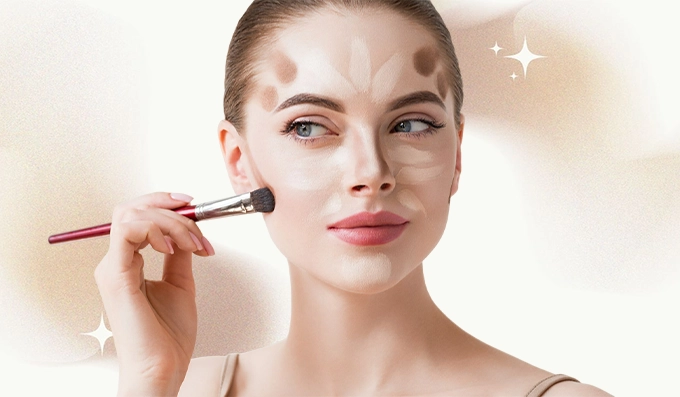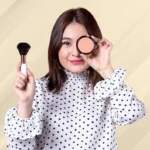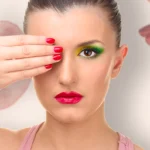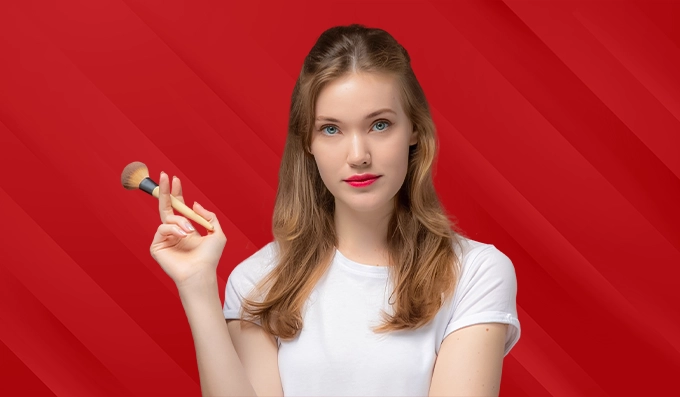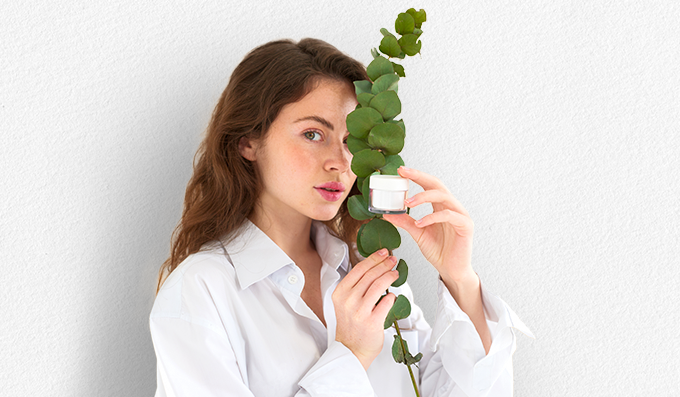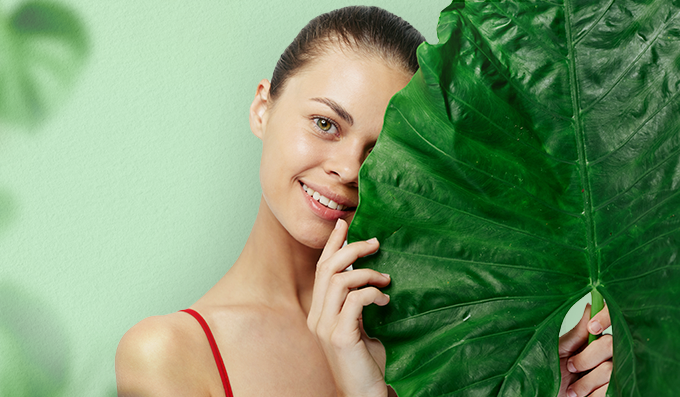Face mapping for makeup is about really seeing how your face is built. It means to see your bone structure, angles, and where light naturally hits.
Table Of Content
- The 6 Most Common Face Shapes
- Oval Face Shape
- Round Face Shape
- Heart Face Shape
- Diamond Face Shape
- Square Face Shape
- Rectangle (Oblong) Face Shape
- Step-by-Step: How to Map Your Face Like a Pro
- Step 1: Measure your face length
- Step 2: Check your forehead width
- Step 3: Find your cheekbone width
- Step 4: Measure your jawline
- Step 5: Feel the angles
- Step 6: Trace your face shape (optional)
- Step 7: Match what you see
- Common Mistakes When Mapping Face Shape
- Only Going by Width, Not Angles
- Using Filters to Judge Shape
- Weight Changes Affect Perception
- Ignoring the Brow Tail
- Under- or Over-Mapping Your Brows
- Using the Wrong Tools
- Skipping Symmetry Checks
- Not Considering Your Face Shape for Brow Style
- Pro Tools & Apps to Try
- Wrap-Up
Because honestly, even the best makeup tricks fall flat if they’re not placed right. That’s why it’s key to map your face shape like a pro instead of copying random tutorials. The right contour for your face shape and proper blush placement for your face shape make all the difference.
In this blog, we will discuss how to map your shape like a pro. We will share tricks and tools to map your face shape accurately. Once you get the hang of it, your whole routine gets way easier, and your makeup looks way better.
The 6 Most Common Face Shapes
Knowing your face shape is the secret to makeup that works for you. It affects how you contour, where you put your blush, and even which hairstyles and glasses look good.
Most faces fall into these six basic shapes:
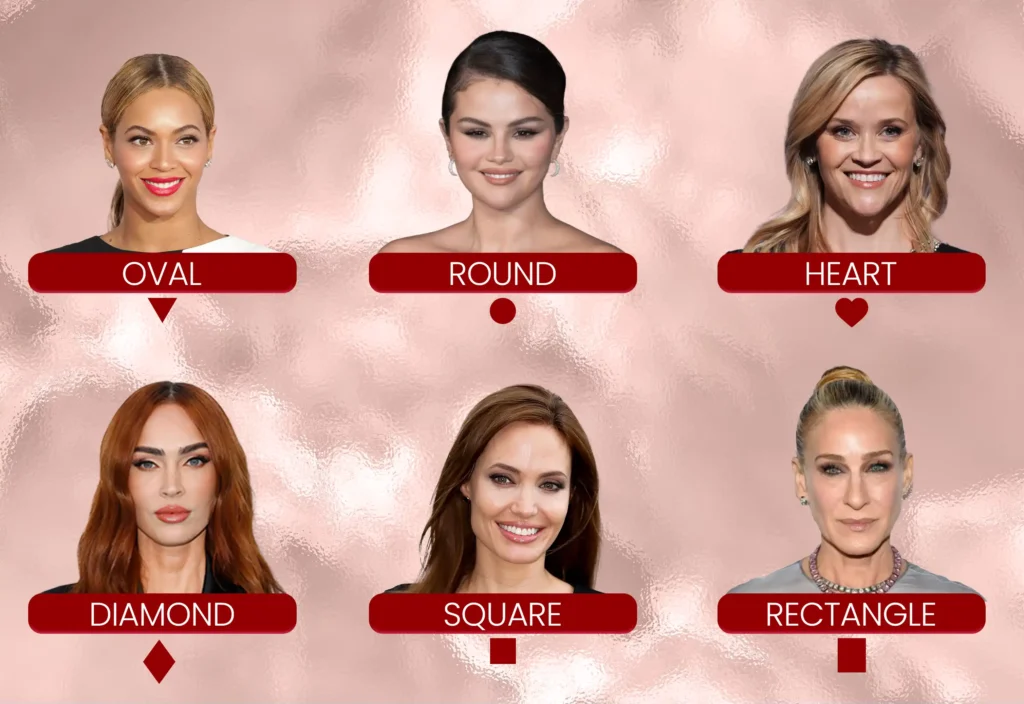
Oval Face Shape
Example: Beyoncé
Oval faces are often called the “perfect” face shape. That’s because they’re balanced and pretty much work with every makeup style.
If you have an oval face, your face will be a bit longer than it is wide. Your cheekbones will be the widest part, and both your forehead and jaw will gently taper in.
Round Face Shape
Example: Selena Gomez
Round faces are soft and youthful-looking. Your face will be almost as wide as it is long, with full cheeks and a rounded jawline. The overall shape is kind of like a circle.
When you look in the mirror, you won’t see many sharp angles. Your forehead and jawline curve softly. This gives you a fresh, approachable vibe.
Heart Face Shape
Example: Reese Witherspoon
Heart-shaped faces are wider at the top and narrow down to a pointed chin. Think of an upside-down triangle or a heart symbol.
Your forehead will be your widest feature, sometimes with a widow’s peak. Your cheekbones will be high and noticeable. Your jawline narrows quickly, leading to a sharp chin.
Diamond Face Shape
Example: Megan Fox
Diamond-shaped faces have strong angles and high cheekbones. Your cheeks will be the widest point, while your forehead and jawline are narrower.
The chin usually comes to a point, but your face feels more angular than the heart shape.
Square Face Shape
Example: Angelina Jolie
Square faces have strong, bold features. Your forehead, cheekbones, and jawline will be about the same width.
Your jawline is probably very defined and angular, giving your face a boxy look.
Rectangle (Oblong) Face Shape
Example: Sarah Jessica Parker
Rectangle faces are longer versions of square faces. Your face length will be noticeably longer than its width.
Your forehead, cheekbones, and jawline will all be about the same width, but your face will look stretched vertically.
Read Below to Know More: 3 Steps to Finally Answer This Question: What Is My Face Shape?
Step-by-Step: How to Map Your Face Like a Pro
Mapping your face takes a little patience and some honest eyeballing.
First things first, tie your hair back so nothing blocks your view. Now, grab a flexible tape or even a piece of string and a ruler. Here’s a step-by-step guide on how to map you face shape like a pro:
Step 1: Measure your face length
This is the first step to determine your face shape accurately. Place the tape at your hairline, right in the middle of your forehead. Measure straight down to the tip of your chin. That’s your face length. Simple.
This helps you figure out if your face is more on the long side or more balanced.
Step 2: Check your forehead width
Next, measure across your forehead at its widest point. Usually just above your eyebrows. Is it wide or narrow compared to the rest of your face? That matters.
Step 3: Find your cheekbone width
Your cheekbone measurement often shows where your face is naturally the widest. Measure from the edge of one cheekbone across to the other, right under your eyes.
Step 4: Measure your jawline
Starting under one ear, run your tape along the edge of your jawline down to your chin’s center. Double that number for the full jaw width. This jawline measurement tells you whether you lean toward a square face shape or a softer oval look.
Step 5: Feel the angles
Numbers help, but touch your face, too. Is your jaw rounded or sharp? Are your cheekbones high or more subtle? This will give you clues your tape measure can’t.
Step 6: Trace your face shape (optional)
If you want, grab a white eyeliner and lightly outline your face on the mirror. Or snap a selfie and draw over it in any photo app.
This trick makes it way easier to see your shape at a glance.
Step 7: Match what you see
Now, compare your notes to the different types of face shapes: oval, round, heart, square, diamond, or rectangle.
Don’t stress perfection. Faces are unique. Just find the shape that feels like you.
Once you map your face shape like a pro, every step of your makeup routine falls into place more easily. Hairstyles suddenly make sense. Even sunglasses fit better.
Common Mistakes When Mapping Face Shape
Trying to map your face shape like a pro might sound simple, but some mistakes can throw you off.
Here are the most common mistakes people make and how to avoid them:
Only Going by Width, Not Angles
One of the biggest face mapping mistakes is relying only on width instead of angles. But your face isn’t just about width. Ignoring those can lead you to pick the wrong shape, and that means your makeup or brows won’t highlight your features properly.
Using Filters to Judge Shape
Filters can distort your face. Relying on Instagram or Snapchat filters to figure out your face shape will usually give you a misleading result. Always check yourself in a mirror with no filters.
Weight Changes Affect Perception
Your face shape can look different if you gain or lose weight. Cheeks might appear fuller or your jawline sharper. Don’t lock yourself into one shape forever. Check your measurements every once in a while to stay on point.
Ignoring the Brow Tail
This is a subtle one, but it matters. The tail of your brow frames your eyes and balances your face. Skipping it or shaping it wrong can throw off the whole look.
Under- or Over-Mapping Your Brows
Under-mapping means you leave too many stray hairs, so your brows look messy. Over-mapping means you pluck too much and end up with thin or uneven brows. Either way, it’s a no-go. Use the right tools and be precise.
Using the Wrong Tools
Trying to map with a cheap pencil or no measuring tool at all? That’s a recipe for frustration. Invest in a quality brow pencil, stencils, or even just a good measuring tape. It makes all the difference.
Skipping Symmetry Checks
Brows don’t have to be twins, but they should be close enough to avoid looking uneven. Take your time to compare both sides in good light and adjust carefully.
Not Considering Your Face Shape for Brow Style
Every face shape calls for a different brow style. For example, a round face usually needs a higher arch to add length, while a square face benefits from softer arches to soften the angles. Ignoring this can mess up your whole look.
Pro Tools & Apps to Try
Getting your face shape right is way easier when you’ve got the right tools. You can also try face shape measurement tools or even face shape detection apps for extra guidance. Here’s what I usually keep on hand:
- Measuring tape or string: Use it to measure your forehead, cheekbones, jawline, and face length. String works if you don’t have tape; just mark it and measure with a ruler.
- White eyeliner pencil: Perfect for tracing your face shape on the mirror. It shows up clearly but wipes off easily, so no stress.
- Selfie apps with grid overlays: These let you snap a photo and see straight lines to help judge angles and symmetry. A quick way to check yourself without second-guessing.
- Face shape detection apps: Some apps try to tell you your face shape automatically. They can be fun, but take their results with a grain of salt. They’re not always accurate. Still, they can help you map your face shape like a pro with more accuracy.
Wrap-Up
At the end of the day, when you map your face shape like a pro, your makeup finally works with your features instead of against them. When you map your face shape like a pro, everything, from contour for your face shape to hairstyles, starts to click. We’d love to see how you tried our tricks to map your face. Tell us in the comments below!


